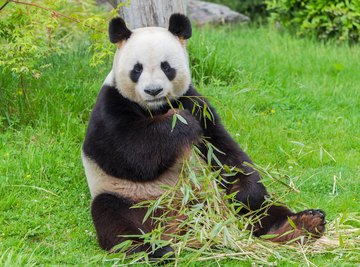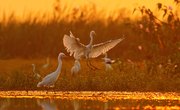
The debate rages on whether zoos offer the best option to protect animals facing extinction. On one side of the fence, you have scientists who state that zoos can help an endangered species thrive; detractors state that the best way to protect a threatened species is to create protective preserves where they can breed naturally. The one topic both groups agree on is that human impact on wildlife ecosystems affects, threatens and disrupts animals and plants that depend on these communities.
Extinction Estimates – Real or Exaggerated?
Most scientists and people agree that human encroachment on ecosystems around the world threatens the survival of all animal and plant life that depend on these to survive. Worldwide ecologists and experts boldly claim that humans are responsible for all or part of the wildlife extinctions that continue to occur.
The Millennium Ecosystem Assessment, a study ordered by the United Nations and begun in 2002 and compiled by more than 1,350 scientific experts worldwide, estimated that at least 24 species a day or 8,700 species per year go extinct.
The United Nations Convention on Biological Diversity in 2007 disagreed with that figure, as it indicated that rate as upwards of 150 species per day. But to date, the International Union for the Conservation of Nature claims only 800 species in total have been documented as extinct over the last 400 years. The variance in numbers, writes environmental author Fred Pearce, might be due to the differences in the computer models being used to create the statistics.
The Endangered Species Act
The Endangered Species Act in the United States was signed into law in December of 1973. It “provides for the conservation of species that are endangered or threatened throughout all or a significant portion of their range, and the conservation of the ecosystems on which they depend,” states the U.S. Fish and Wildlife Agency.
Since it replaced the Conservation Act of 1966, the ESA has been amended multiple times to include plants and invertebrates and other wildlife under its protection. To that end, several zoos have taken up captive breeding programs to ensure the continuation of multiple threatened species.
Zoos and Captive Breeding Programs
By 1982, the California Condor was all but extinct, with only 25 to 27 condors living in the U.S. By 1987, all 27 condors were put into a captive breeding program in hopes of keeping them from going extinct. The birds were distributed between two zoos in southern California: The San Diego Zoo and the Los Angeles Zoo. This program was later expanded to include other zoos on the west coast.
The San Diego Zoo built a special aviary enclosure that gave the birds room to spread their wings, fly and mate. The captive breeding program had been so successful that by 1993, some of these massive birds were reintroduced back into the wild in Baja California, California and Arizona.
In the Big Sur area of California in 2006, biologists documented a mating pair with a nest in a redwood tree cavity, the first to be spotted in the wild since release. The captive and wild population of these birds has grown from 23 to over 400 in 2015 due to the success of this program. Zoos have also helped thwart the extinction of other creatures, such as the black ferret.
Captive vs. Wild Breeding
Proponents against captive breeding programs state that such programs can cause animals to inbreed, even when released into the wild, thus changing the evolution of the species by decreasing its genetic diversity.
Some species just won’t mate in captivity, as in the case of Lonesome George, the rare Pinta Island Galapagos tortoise. Taken into captivity in 1972, George was placed in the Tortoise Breeding and Rearing Center on Santa Cruz Island – off the coast of Santa Barbara, California – where he refused to mate with any of the females of a similar species. The last of his line, he died in 2012 in captivity, never having bred.
Arguments against captive breeding programs cite that releasing animals back into the wild can also include the introduction of deadly funguses and bacteria into the natural environment and result in decreased sperm count and low reproduction rates. Another key issue facing released animals is an ecosystem and wildlife habitat that supports them.
Wildlife Preservation and Conservation
Nature’s breeding programs tend to work best, as these programs rely on natural settings and drives to ensure the continuation of the species. But for these ‘natural’ breeding programs to work, animals need a protected preserve or area in which they can live without threat of hunting or poaching. Organizations such as the National Wildlife Federation argue for the protection and restoration of wildlife habitats and the reduction of threats to endangered species in the wild.
Protecting Endangered Species
While species bred in captivity tend to have less genetic diversity and produce smaller litters or broods, sometimes captive breeding is the only solution to protect a species. While zoos might not offer the most ideal options, they do help in educating people about conservation and endangered species and go a long way to protecting animals in threat of extinction.
Conservation efforts seem to work best if they include establishing wildlife habitats and preserves that work together with zoos to ensure endangered species can thrive. Reducing threats to wildlife should include the establishment of protected lands where no hunting or poaching is allowed, provision of contaminate-free water for the animals within the habitat and the reduction or elimination of invasive species not native to the preserve that upset nature’s balance.
Support Zoo Accreditation and Conservation
Accredited zoos, aquariums, rescue organizations, sanctuaries and preserves must adhere to strict standards of care, animal welfare, the education of guests and visitors about wildlife conservation and a commitment to conserve the world’s “wild animals and wild places” to receive accreditation.
When you visit, spend or donate money to these organizations, a portion of your donations fund these efforts. While zoos might not represent the best solution for protecting endangered species, it’s clear by their Species Survival Programs, zoos can have a positive impact on bringing some species back from the brink of extinction.
References
- Scientific American: How do Zoos Help Endangered Animals?
- Millennium Ecosystem Assessment: Overview of the Millennium Ecosystem Assessment
- Yale Environment 360: Global Extinction Rates – Why Do Estimates Vary So Wildly
- National Oceanic and Atmospheric Administration: Endangered Species Act
- California Department of Fish and Wildlife: California Condor
- American Museum of Natural History: Lonesome George
- NRDC: Let the Bustards Be
- University of Washington Conservation Magazine: The Little Known Downsides to Captive Breeding Programs
Resources
About the Author
As a journalist and editor for several years, Laurie Brenner has covered many topics in her writings, but science is one of her first loves. Her stint as Manager of the California State Mining and Mineral Museum in California's gold country served to deepen her interest in science which she now fulfills by writing for online science websites. Brenner is also a published sci-fi author. She graduated from San Diego's Coleman College in 1972.
